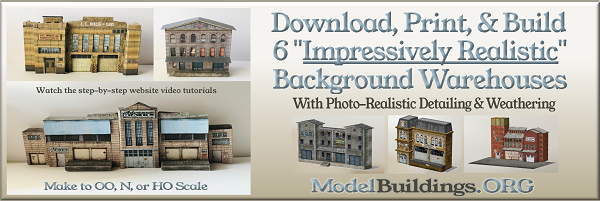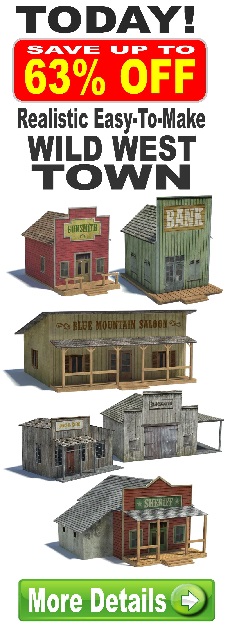Everything on model trains, model railroads, model railways, locomotives, model train layouts, scenery, wiring, DCC and more. Enjoy the world's best hobby... model railroading!
Fixing Problem Track Connections
Jordan asks readers:
“Most of my HO track seems okay except for 3 curved pieces that won’t join perfectly without a slight gap. I am worried about a derailment when cars cross the connections. How can I improve the connections please?”
20 Responses to Fixing Problem Track Connections
Leave a Reply
















If you’re not already, I recommend using flex track with each rail offset to one another. Doing so means the wheels will not both meet with joints in a curve. This greatly lessons the chances of derailments and a smoother ride.
Jordan,
1) in the connections that are having a gap ONLY (clearance), carefully just add a few drops of hard filling (epoxy resin), after it drys make it even or just a bit under the rail top surface, this a permanent fix.
2) or in the other side connectors, the ones that are too tight, file the contact face of one of them.
If you can do this, be very careful due to if you remove too much material in that tight face, the rails will be lose.
Use of a small hand files is recommended, this operation must be made while the tracks are attached to a steady piece of some kind, so you can manipulate the file with both hands.
Hope you understand this,
good luck to you.
Two things you can do:
cut off a small piece from the track so they fit or
build up the gap with solder/filler then file the inside until smooth.
Is the track new? If not, I would suggest just changing out the three offenders with new. Is the track with built-in roadbed like Bachman HO? Is it sectional and hand-ballasted? If so, then it is a bit more difficult to to tea up and redo, but it may be necessary. Good luck 🙂
As you refer to the track as ‘curved’ track I assume it has a per-set radius and known as ‘setrack’ (this is usually supplied with a train set and is also available in pieces with different radius).
Because the radius is set are you trying to create a different radius ?
There are three things you might try.
1/ Cut the moulded sleepers allowing the track to change radius
2/ Fill in the gap with solder.
3/ Replace with a length of ‘flexi-track’ (preferred choice)
I hope this helps
regards
Martin
Jordan, ,I use code 100 track and have ran into track not fitting quite right, take off the connectors on side that you are trying to join and fit the two pieces and see if one rail is longer than the other, of it is, I mark the longer rail with a sharpie and take my dremel with a cutoff and cut the rail, if it still won’t fit together without a gap, replace the problem track, you will save yourself a lot of frustration, hope this helps you, Chuck
Hi Jordan,
Please supply a bit more information.
You say “a slight gap”. Just how much gap is there?
Are you using pre-curved sectional track. Is the gap on the inside curved rail or the outside curved rail?
Jordan,
These are all good fixes, but I would use flex track, they come in lengths long enough to get around A curve, and you won’t have any gaps in your track.
There could be a number of different reasons for this problem.
(That is why there are so many different solutions offered !-)
Fixed curve track comes in various radii, so are you certain that your track sections are the correct curves (and number of sections) that should fit together for a particular track configuration ?
Have the rails moved along the sleepers (US: ties) preventing the fishplates from properly connecting ?
Can you post a (fairly good) close-up image of the gap problem ?
Jordan
Change out the three pre set radius tracks that are giving you problems and put in a piece of Flex Track (4-5 dollars from atlas ) problem solved as Martin suggests choice # 3, keeping in mind that all locomotives require different radius. I hope this helps, if not ,by all means ask more questions we are here to help, good luck.
Phillip. A
I fully agree flex track is probably the best way to go. Even though I am an N scaler I use flex track frequently it is alot there are less gaps and less derailments.
As Mr. Brooks said on last reply, I recommend using flex track as well with each rail connection offset to one another (as I have done on all of my N scale curves) to help avoid de-railments.
My curves are a little bit wider than needed and have a slight tilt to the inside to allow a better turning radius at higher speeds with more cars attached. The slight tilt helps to pull the train around the curve. Since this was suggested in Modelrailroad Magazine, I tried it and it works perfect-at least for me.
Good luck and keep rolling!
Mickael
Make sure radius is correct (use a radius guide) If flextrack make sure the joints are not opposite each other and solder with the guide in place.
A really good closeup photo and a measurement (guestimate) of the gap would be really helpful.
All good answers. Here’s another one. If the gap is small, take a piece of plastic and glue it in the gap with CA (cyano-acrylate) cement. File the plastic down to match the profile of the rail.
This is the usual recommended way to create an insulated gap when you need to isolate a section of track.
Otherwise, I would try to fill the gap with solder and file it to shape.
I am using flex track to build my layout, so that solves a number of issues with radius and curvature.
MAKE SURE THE THREE CURVE PIECES ARE THE SAME RADII..
THAT COULD BE YOUR PRROBLEM. PLAIN AND SIMPLE.
Please advise what the problem is/was when you find it.
DON
All this is correct fill it in and file it /also make sure the pieces are correct radii /and same code / flex track works best just remember one rail of flex track is fixed and the other floats or slides in the ties make sure the track in place before you cut it.I always keep the floating rail to the outside and make it up one one end before I cut it. Don/joe/peter/douglas/ all of them are correct just use one fix and run a car back and forth to check it make sure the wheels a gauged correct I use a metal wheel for this.
I guess from the information given that you are using set track curves. The only reason why gaps between pieces is because you are trying to force a fixed radius track into a configuration that distorts its geometry. Make sure your track is set at the true radius, or, as suggested above change over to flex track. This has the advantage of being more forgiving regarding radii, is easy to use, and cheap. Have fun, don’t get too hung up and be prepared to tweak your layout design, but never try and force set track into places it doesn’t want to go – it will always fight back and spoil your day.
If you are using atlas or similar track set in plastic ties, the metal part (rails) track may be loose and have moved making the fit uneven. Replacing said track is best solution if that is the case.
Just replace the three sections with new. 😉